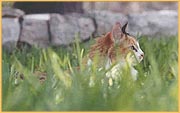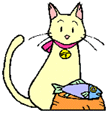Table of Contents
Assist Feeding – How Much to Feed, Part II
Feline Nutrition – The Right Food
Pro-Active Cat Care – Advance Training?
Feline Obesity – Day Dream Material
Message from the Editor
This week Linda Fischbach is our guest writer!
Thank You Linda! Be sure to read her story “Pro-Active Cat Care – Advance Training?”
Assist Feeding – How Much to Feed, Part II
by Kathy Fatheree
Last week I encouraged you to work with you vet in determining how much to feed your kitty to either gain weight or maintain weight. Did you have a chance to play with the Enternal Nutrition Calculator presented by Dr. Wingfield and Dr. Bowen of Colorado State University? This calculator is great for getting a ballpark value. Some kitties require less food, others require more.
Let’s take an example: Let’s say that Mr. Tom cat was 18 pounds before he stopped eating. He was a bit, er… fluffy at 18, so losing weight was a good thing, but he lost muscle along with the fat so it really was a bad thing. Tom is down to 10 pounds, and for his large frame, 12 pounds is our target.
Step 1: Calculate basal energy requirement: Our target is 12 pounds or 5.44 kg. (metric calculator) Enter 5.44 in the body weight box, then click your mouse pointer in the “BER” box and 233.2 appears.
Step 2: Calculate maintenance energy requirement: Review the Status table and choose the appropriate factor. The more tissue healing required, the higher the number and the more food required. If you don’t know why your kitty is not eating, use the Cage Rest Factor for now. In our example we will use 1.00 since Tom has not had surgery or other major trauma. Enter 1.00 in the “Enter Factor” box, then click in the MER box and 233 appears. This means that Tom needs to eat 233 kcal/day.
Step 3: Calculate Volume of Formula Required: This webpage continues and has a few foods to choose from to calculate how many ml of food to feed. If your food is not listed, call the food producer and tell them how many kcal/day your cat needs and ask them how many milliliters (ml) will provide that. For our example, we use Feline Hills a/d. Click the “Feline/Canine a/d Hills” button, scroll down and you will see that I need to feed Tom 179 ml/day. I am using 14 ml syringes, so that means I need to feed Tom approximately 13 syringes per day. I am feeding Tom 4 times a day, and for us, that works out to 3 syringes per feeding.
NOTE: Your cat may require more or less food since each cat’s metabolism if very, very different. If you are not feeding enough food, gradual weight loss will occur. It is imperative that you either buy an accurate baby scale or postal scale, or take your cat to the vet each week for weighing (assuming they have an accurate scale that weighs to the ounce and not just a general scale.)
Feline Nutrition – The Right Food
by Garry White
I don’t know about you, but I’m a lazy cuss! It would be a lot simpler if someone would just tell me what to feed Fluffy! But who would tell me? The cat-food manufacturers? Nah, they’re biased to their own product. How about Sue across the street…she’s had cats for a long time, surely she’ll know, right? Nah, she can only tell me what works for her cat. The vet! I’ll ask the vet; he’ll know what’s the best food for Fluffy! Sure he knows; the brand he sells is best for Fluffy. Well, shucks!
Look, it’s not up to the vet, the pet-food manufacturer, or Sue. It’s up to you, because your cat is unique, and a number of variables will determine what’s the best food: Age, weight, temperament, overall health condition, eating habits, preferences, and so on. The right food is out there, believe that, and the manufacturers give us more product information now than ever before. The problem is that most of us are confused by what the labels tell us, and that’s understandable. We’re selective in what we feed our human family members, but trying to understand that cat-food label makes us wish we’d gone to school the day they taught math…YIKES!
Relax; it’s not as confusing as you think, and this week we’re going to untangle the mysteries together.
![]()
Feline Nutrition: The Right Cat Food
ProActive Cat Care – Advance Training?
by Linda Fischbach
You all know that Kathy and I encourage new writers to contribute here, and this week I’m giving up my glorious throne to one of our very own, Linda Fischbach, who has taken the time to bring us something well worth reading.
We like to prepare ourselves and our cats for future problems. What if I suggested something you could do now, with your kitten (or your 10 year old cat), that would make handling a future illness or injury much easier? This is my suggestion: get all of your cats used to a syringe. This can be done by filling a small (3ml or 5ml) syringe with tasty meat baby food (pureed kitty tuna would work, too) and offering it to your kitty. Most cats will want that baby food; he may not understand you putting a syringe in his mouth, but a small squirt of that tasty baby food and he’ll forget the syringe. At first do this a few times a week, and kitty will associate that syringe with a treat. Then do this every so often, so kitty remembers that the syringe is a good thing.
Almost any medication can be compounded into a liquid that can be given by syringe (include some tasty food in the syringe if the med is nasty tasting), and if the medication is given by pill/capsule, it should still be followed by a syringe-full of water or liquidy food. If your cat won’t eat, whether it is a temporary situation due to an injury or illness, or a permanent situation due to a chronic illness, being able to syringe food into him could be a lifesaver. If he’s used to the syringe, this won’t be the traumatic experience that it could be. And being able to syringe feed might save your cat from having a feeding tube, which may be necessary to avoid or treat Hepatitic Lipidosis. I have syringe fed my CRF (chronic renal failure) cat for over 2 years; he will eat on his own, but only junk food, which could make his CRF worse. When another cat came home following hernia surgery, she wasn’t interested in eating. When she still wouldn’t eat the next morning, I pureed some food and got out my syringe. She started eating on her own a few days later!
In June 2003, we found six 7-week old kittens in our woods and brought them onto our enclosed porch. Several of them were anemic due to being covered with ticks, and wouldn’t eat. I pureed canned kitten food and syringe fed them just a bit every couple of hours. Within a day or two they were eating on their own (and we’d removed the ticks). But several months later they needed worm medication (yes, we kept them), and it was so easy because they weren’t afraid of the syringe.”
Feline Obesity – Day Dream Material
by Kathy Fatheree
 After I graduated college, I moved into my first apartment and soon had two adorable kittens. I lived in apartments for many years and I always felt guilty for keeping my cats indoors all the time. I knew they would prefer to be outdoor cats – natural cats. As my cats grew older, I started taking them outside for walks and to gather what I called “Day Dream Material.” I could only imagine how boring it was in the apartment. I lived in one apartment that was a very calm, safe environment. I never saw dogs roaming alone and only the occasional cat. I would take only one cat at a time and we would go on a walk. We walked and explored every afternoon.
After I graduated college, I moved into my first apartment and soon had two adorable kittens. I lived in apartments for many years and I always felt guilty for keeping my cats indoors all the time. I knew they would prefer to be outdoor cats – natural cats. As my cats grew older, I started taking them outside for walks and to gather what I called “Day Dream Material.” I could only imagine how boring it was in the apartment. I lived in one apartment that was a very calm, safe environment. I never saw dogs roaming alone and only the occasional cat. I would take only one cat at a time and we would go on a walk. We walked and explored every afternoon.
Sometimes I could allow only 30 minutes per cat, but oh what fun they had! They seemed to know that their walking time was limited so they would seek out new territories to explore each day. We would sometimes walk up neighbors stairs to see what mysteries were on the 2nd and 3rd floors. Other days we walked the fence line and peered under the wooden slats to imagine the adventures on “greener grass.” I know that our daily walks increased metabolism and equally important, it elevated happiness and mood. I too was happier knowing that while I was at work and my kitties were staring out the window, their minds were working hard and thinking up new day dream material adventures.
Disclaimer: Kathy Fatheree is not at all a medical expert. Contents of this web site are a collection of Kathy’s assist feeding experiences as well as the experiences of other cat owners who have assist fed their cats. While every effort has been made to ensure the accuracy of the information, Kathy Fatheree or anyone associated with this web site cannot be held responsible for anything that may happen as a result of using the information on this site.
